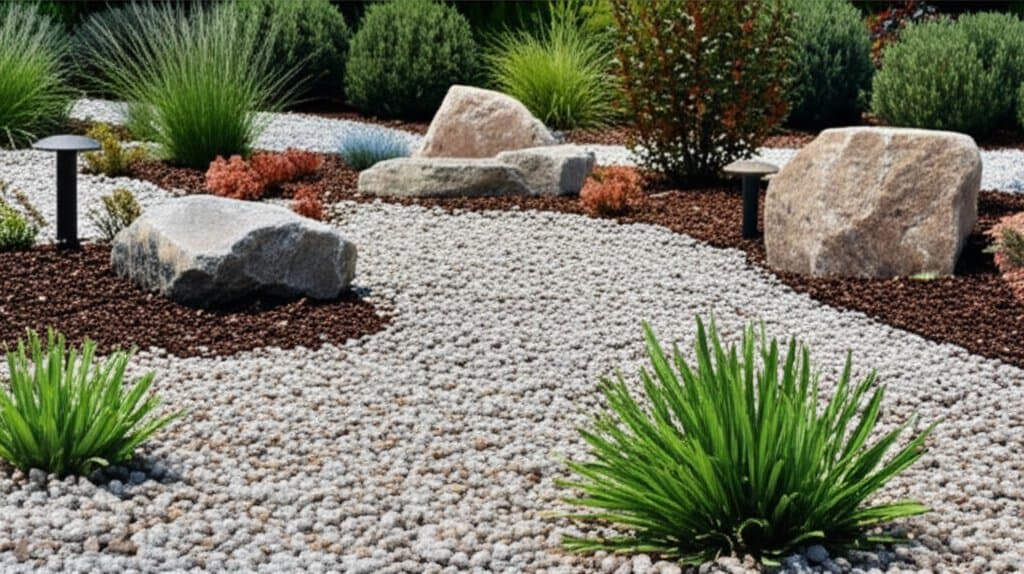Gravel Gardens: Low-Maintenance Landscapes That Replace Mulch
Gravel gardens reshape low-maintenance landscapes for homeowners and designers. These designs provide structure, texture, and visual interest while reducing the need for frequent watering and weeding. The outcome is an outdoor space that appears natural, remains tidy, and requires less attention than traditional mulch beds.
The appeal stems from simplicity. Gravel suppresses weeds, moderates soil temperature, and endures for years without replacement. It complements drought-tolerant plants and aligns with modern aesthetics. For many, this approach serves as a practical alternative that maintains freshness across seasons.
1. Define the Surface with Purpose
Gravel serves as more than filler between plants. It acts as the canvas for the landscape. Selecting the appropriate size and type establishes structure and sets the overall tone.
A designer notes: Start with gravel that complements your architecture. Rounded pea gravel softens edges, while crushed granite conveys crisp modernity.
Functional benefit: Gravel forms permeable surfaces that drain effectively, avoiding puddles and erosion. It also stabilizes paths and seating areas.
Design insight: Blend colors with intention. Pair warm limestone chips with Mediterranean herbs or cool gray slate with succulents to create contrast.
Example: In a backyard dining area, decomposed granite frames the space and transitions into planting beds covered with 1/4-inch crushed limestone. This combination appears cohesive and remains neat after rainfall.
2. Layer Gravel for Structure and Drainage
A well-constructed gravel garden begins below the surface. Proper layering prevents weeds and ensures stability. Neglecting this step invites future issues.
A contractor advises: A compacted base of crushed stone topped with decorative gravel ensures longevity. This method keeps the surface firm and resistant to sinking.
Functional benefit: Layers enhance drainage and restrict weed growth. They also improve comfort on walking surfaces and prevent ruts.
Design insight: Employ varying gravel sizes for depth. Begin with 3/4-inch base rock, then apply smaller decorative gravel on top. This variation in texture imparts a professional finish.
Example: In a side yard, a 3-inch base of crushed granite supports a layer of fine gravel. The path feels natural underfoot and avoids puddling during storms.
3. Add Contrast with Planting Pockets
Excessive gravel risks appearing monotonous. Planting pockets interrupt the surface and introduce rhythm. These deliberate spaces accommodate lush accents while preserving low-care benefits.
A designer suggests: View gravel as the backdrop. Small planting pockets provide bursts of color without introducing clutter.
Functional benefit: Focused planting zones simplify irrigation, as only targeted areas require water.
Design insight: Arrange species in odd-numbered groups for a natural appearance. Maintain sufficient gravel around each plant to highlight its form.
Example: A compact courtyard features gravel coverage with circular pockets of lavender, agave, and Mexican feather grass. The arrangement feels sculptural yet relaxed.
4. Control Weeds Effectively
Weeds may emerge in gravel gardens over time. The objective is to address them early. Thorough preparation and periodic inspections maintain pristine surfaces.
A gardener observes: A breathable weed barrier beneath the gravel proves highly effective. It permits rainwater infiltration while blocking root penetration from below.
Functional benefit: This approach reduces hand-pulling and herbicide use throughout the season.
Design insight: Select high-quality woven fabric rather than plastic sheeting for enduring performance.
Example: A gravel terrace constructed over fabric and a compacted base remains weed-free with little effort. A brief raking every few weeks preserves its freshness.
5. Maintain with Routine Care
Gravel gardens demand low maintenance, though not zero effort. Seasonal attention ensures an intentional appearance. Regular checks prevent compaction and sustain vibrancy.
A maintenance professional recommends: Rake gravel periodically to level footprints or wheel marks. Replenish thin areas before weeds establish.
Functional benefit: This practice upholds clean surfaces and averts drainage problems.
Design insight: Keep a reserve of matching gravel for repairs. Exposure to sun and rain may subtly shift color, so integrate new material with existing to preserve uniformity.
Example: A homeowner renews the top half-inch of gravel every few years. The garden retains the look of a recent installation, even after extended use.
Integrating Gravel into Daily Outdoor Life
A gravel garden evolves with grace. Plants establish roots, and stones develop a softened patina. The surface offers a satisfying crunch underfoot, remaining functional across seasons. What starts as a pragmatic choice becomes a central landscape element.
Balance proves essential. Apply gravel to bolster structure and reserve planted areas for vitality and motion. This straightforward method encourages consistent care and promotes effortless outdoor enjoyment. In time, the garden embodies both modernity and enduring appeal, demonstrating that minimal upkeep supports exceptional design.

